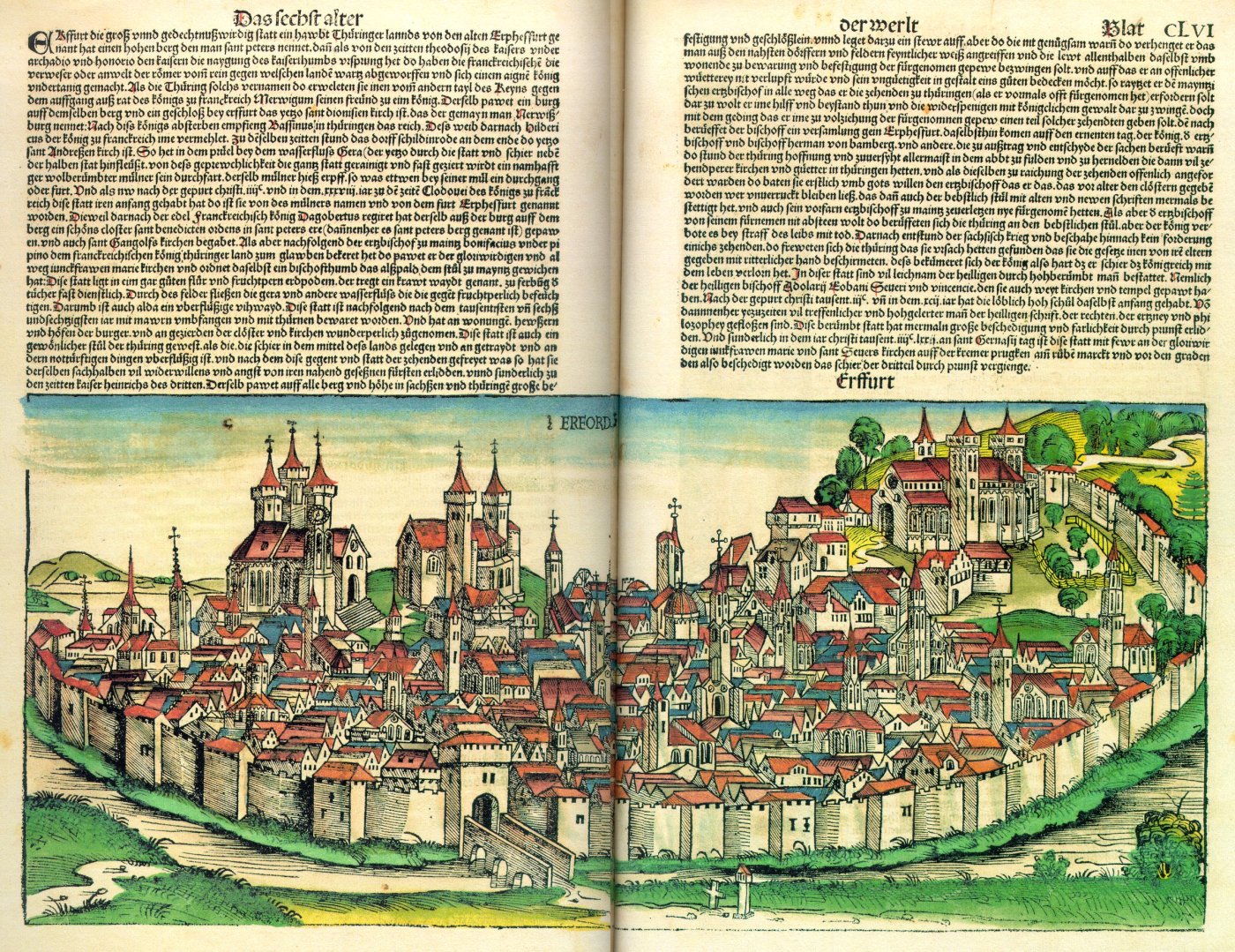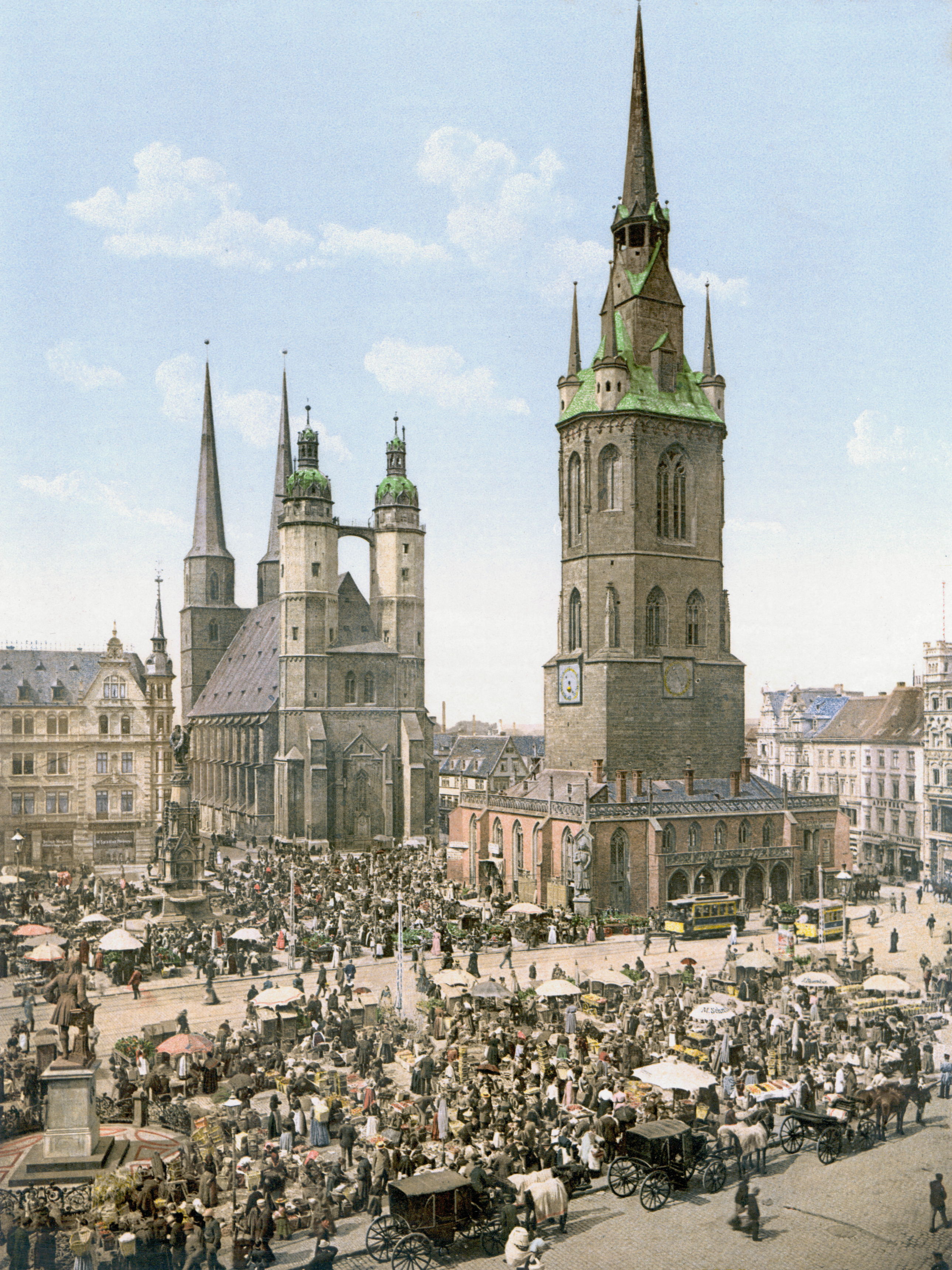|
Leipzig Trade Fair
The Leipzig Trade Fair () is a major trade fair, which traces its roots back for nearly a millennium. After the Second World War, Leipzig fell within the territory of East Germany, whereupon the Leipzig Trade Fair became one of the most important trade fairs of Comecon and was traditionally a meeting place for businessmen and politicians from both sides of the Iron Curtain. Since 1996, the fair has taken place on the Leipzig fairgrounds, located about north of the city centre. History Early history The history of the Leipzig fairs goes back to the Middle Ages. A fair held at Leipzig is first mentioned in 1165. Otto the Rich, Margrave of Meissen presented the Leipzig fairs under protection. No other fair was allowed within a circle of an ( German) mile (7.5 km) away ( Bannmeile). In 1268, Margrave Theodoric of Landsberg assured all merchants travelers to Leipzig full protection for person and goods, even if their sovereign was at feud with him. This led to the settleme ... [...More Info...] [...Related Items...] OR: [Wikipedia] [Google] [Baidu] |
Leipzig Merchant Bourgeoisie
The Leipzig merchant bourgeoisie (in German: ''Leipziger Handelsbürgertum'') refers to a historical social subgroup of the bourgeoisie in Leipzig, Germany, that was formed from the urban patriciate in the Middle Ages and existed as a prominent social class from around the middle of the 16th century until its dissolution in 1945. The merchant bourgeoisie owed its rise to the city's location at the intersection of two important trade routes - Via Regia and Via Imperii - for long-distance trade and to the imperial trade fair privilege of 1497 (Reichsmesseprivileg), which elevated the city to the status of an imperial trade fair. The dissolution of the urban social class took place through overarching transformation processes with the aim of establishing a socialist society in East Germany. Groups The Leipzig merchant bourgeoisie represented the largest group of the entire Leipzig upper class. These were merchants, manufacturers, banking families, publishers, and in a broader sense ... [...More Info...] [...Related Items...] OR: [Wikipedia] [Google] [Baidu] |
Alte Handelsbörse
The Alte Handelsbörse or Alte Börse (Old Exchange (organized market)#History, exchange) in Leipzig, Saxony, Germany, is the city's oldest assembly building of merchants, and also the oldest Baroque architecture, Baroque building. Built as the Börse in 1678, it is now used as an event venue and is known in English as the Old Stock Exchange. History Leipzig has always been an important trading centre, being at the intersection of two historical trade routes, and trade fairs have been held here for nearly a millennium. The initiative to build a Börse, as a neutral exchange place to conduct business and seal deals, came in 1667 from 30 major merchants after complaints by foreign merchants. The city council took the decisive decision to build the Börse on 6 May 1678. The building was probably designed by , a master builder at the court of John George II, Elector of Saxony, in Dresden. Construction began at the Naschmarkt (Leipzig), Naschmarkt adjacent to the Old Town Hall (Leipz ... [...More Info...] [...Related Items...] OR: [Wikipedia] [Google] [Baidu] |
Fugger
The House of Fugger () is a German family that was historically a prominent group of European bankers, members of the fifteenth- and sixteenth-century mercantile patriciate of Augsburg, international mercantile bankers, and venture capitalists. Alongside the Welser family, the Fugger family controlled much of the European economy in the sixteenth century and accumulated enormous wealth. The Fuggers held a near monopoly on the European copper market. This banking family replaced the Medici family who influenced all of Europe during the Renaissance. The Fuggers took over many of the Medicis' assets and their political power and influence. They were closely affiliated with the House of Habsburg whose rise to world power they financed. Unlike the citizenry of their hometown and most other trading patricians of German free imperial cities, such as the Tuchers, they never converted to Lutheranism, as presented in the Augsburg Confession, but rather remained with the Roman Catholi ... [...More Info...] [...Related Items...] OR: [Wikipedia] [Google] [Baidu] |
Barthels Hof
Barthels Hof is a former trade court building complex in Leipzig in Germany, located in the borough Mitte. It is the last “through courtyard” that was preserved almost in its original condition. That means, the carts drove in, the goods were unloaded, and the carts drove out - without turning around. The horses were stabled in the suburbs. Later, from 1893 on, only samples of the goods were shown in the trade fairs and made to order. The Barthels Hof stretches from the market square to Kleine Fleischergasse and is now one of the city's most important sights. Today, it is used for a restaurant and some small shops. History Barthels Hof was built between 1747 and 1750 by George Werner (1682-1758) for the Leipzig merchant Gottlieb Barthel, when ″Leipzig was one of the leading trade and trade-fair cities on the continent". The baroque facade facing Fleischergasse is very narrow and inconspicuous, in contrast to the big building complex behind it. Four-story houses are arranged ... [...More Info...] [...Related Items...] OR: [Wikipedia] [Google] [Baidu] |
Markt (Leipzig)
The Markt (lit.: market) is a square of about in Leipzig's district of Mitte (neighborhood ''Zentrum''), Germany. It is considered the center of the city. The Old Town Hall stands on it, which demonstrates its particular historical importance. The square was named ''Platz des Friedens'' (lit.: Peace Square) from 1950 to 1954. Its paving is a listed heritage monument. Shape The Markt is an almost rectangular square, about long, with its larger extension running almost exactly from north to south. Its mean width is about , being about wider in the north than in the south. Seven inner-city streets lead to it. The square is paved in granite with a diamond pattern inlaid with darker stones. The average edge length of the rhombuses is about , with the size of the rhombuses adapting to the different widths of the square. The coat of arms of Leipzig is inlaid in colored stones in the central diamond at the level of the town hall tower. Cobbled driveways named ''Markt'' run along t ... [...More Info...] [...Related Items...] OR: [Wikipedia] [Google] [Baidu] |
Welser
Welser was a German banking and merchant family, originally a patrician family based in Augsburg and Nuremberg, that rose to great prominence in international high finance in the 16th century as bankers to the Habsburgs and financiers of Charles V, Holy Roman Emperor. Along with the Fugger family, the Welser family controlled large sectors of the European economy, and accumulated enormous wealth through trade and the German colonization of the Americas, including slave trade. The family received colonial rights of the Province of Venezuela from Charles V, who was also King of Spain, in 1528, becoming owners and rulers of the South American colony of Klein-Venedig (within modern Venezuela), but were deprived of their rule in 1546. Philippine Welser (1527–1580), famed for both her learning and her beauty, was married to Archduke Ferdinand, Emperor Ferdinand I's son. Claiming descent from the Byzantine general Belisarius, the family is known since the 13th century. By the ... [...More Info...] [...Related Items...] OR: [Wikipedia] [Google] [Baidu] |
Augsburg
Augsburg ( , ; ; ) is a city in the Bavaria, Bavarian part of Swabia, Germany, around west of the Bavarian capital Munich. It is a College town, university town and the regional seat of the Swabia (administrative region), Swabia with a well preserved Altstadt (historical city centre). Augsburg is an Urban districts of Germany, urban district and home to the institutions of the Augsburg (district), Landkreis Augsburg. It is the List of cities in Bavaria by population, third-largest city in Bavaria (after Munich and Nuremberg), with a population of 304,000 and 885,000 in its metropolitan area. After Neuss, Trier, Worms, Germany, Worms, Cologne and Xanten, Augsburg is one of Germany's oldest cities, founded in 15 BC by the Romans as Augsburg#Early history, Augusta Vindelicorum and named after the Roman emperor Augustus. It was a Free Imperial City from 1276 to 1803 and the home of the patrician (post-Roman Europe), patrician Fugger and Welser families that dominated European ban ... [...More Info...] [...Related Items...] OR: [Wikipedia] [Google] [Baidu] |
Erfurt
Erfurt () is the capital (political), capital and largest city of the Central Germany (cultural area), Central German state of Thuringia, with a population of around 216,000. It lies in the wide valley of the Gera (river), River Gera, in the southern part of the Thuringian Basin, north of the Thuringian Forest, and in the middle of a line of the six largest Thuringian cities ('':de:Thüringer Städtekette, Thüringer Städtekette''), stretching from Eisenach in the west, via Gotha, Erfurt, Weimar and Jena, to Gera in the east. Together with Kassel and Göttingen, it is one of the cities with more than 100,000 inhabitants lying closest to the geographic centre of Germany. Erfurt is south-west of Leipzig, north-east of Frankfurt, south-west of Berlin and north of Munich. Erfurt's old town is one of the best preserved medieval city centres in Germany. The Gera (river), Gera is spanned by the Krämerbrücke, Merchants' Bridge (''Krämerbrücke''), one of the rare bridges with ho ... [...More Info...] [...Related Items...] OR: [Wikipedia] [Google] [Baidu] |
Halle, Saxony-Anhalt
Halle (Saale), or simply Halle (), is the second largest city of the German state of Saxony-Anhalt. It is the sixth-most populous city in the area of former East Germany after (East) Berlin, Leipzig, Dresden, Chemnitz and Magdeburg as well as the 31st-largest city of Germany. With around 226,000 inhabitants, it is less populous than the state capital, Magdeburg. With Leipzig, the largest city of Saxony, Halle forms the polycentric Leipzig-Halle conurbation. Leipzig/Halle International Airport lies between the two cities, in Schkeuditz. The Leipzig-Halle conurbation is at the heart of the larger Central German Metropolitan Region. Halle has been known by many names throughout its history. From the 15th to the 17th century: ''Hall in Sachsen''. From then until the beginning of the 20th century, the name Halle an der Saale was used, and still remains a more formal reference for the city. Additionally, from 1965 to 1995 the city was referred to as ''Halle/Saale''. Halle lies i ... [...More Info...] [...Related Items...] OR: [Wikipedia] [Google] [Baidu] |
Naumburg
Naumburg () is a town in (and the administrative capital of) the district Burgenlandkreis, in the state of Saxony-Anhalt, Central Germany (cultural area), Central Germany. It has a population of around 33,000. The Naumburg Cathedral became a UNESCO World Heritage Site in 2018. This UNESCO designation recognizes the processes that shaped the European continent during the High Middle Ages between 1000 and 1300: Christianization, the so-called "Landesausbau" and the dynamics of cultural exchange and transfer characteristic for this very period. History The first written record of Naumburg dates from 1012, when it was mentioned as the ''new castle'' of the Ekkehardinger, the Margrave of Meissen. It was founded at the crossing of two trade-routes, Via Regia and the Regensburg Road. The successful foundation not long beforehand of a ''Propstei'' Church on the site of the later Naumburg Cathedral was mentioned in the Merseburg Bishops' Chronicles in 1021. In 1028 Pope John XIX gave hi ... [...More Info...] [...Related Items...] OR: [Wikipedia] [Google] [Baidu] |
Merseburg
Merseburg () is a town in central Germany in southern Saxony-Anhalt, situated on the river Saale, and approximately 14 km south of Halle (Saale) and 30 km west of Leipzig. It is the capital of the Saalekreis district. It had a diocese founded by Archbishop Adalbert of Magdeburg. The University of Merseburg is located within the town. Merseburg has around 35,000 inhabitants. Names * * * * * * Geography The town Merseburg consists of Merseburg proper and the following four ''Ortschaften'' or municipal divisions:Hauptsatzung der Stadt Merseburg § 15, April 2019. * Beuna (Geiseltal) * [...More Info...] [...Related Items...] OR: [Wikipedia] [Google] [Baidu] |







